Ecological Importance Of Algae
From the smallest phytoplankton to kelp strands measuring several feet long, many species of algae occur worldwide. Algae species are found not only in ocean waters, but also in damp places on land, and even in the fur of animals such as the three-toed sloth. A key component of ocean food webs, as well as a contributor to the formation of clouds, algae play a major role in the ecosystems of the world.
Algae Forms
Algae Forms
The name algae refers to numerous unrelated plant and plant-like organisms dwelling both in water and on land. Algae occur as single-celled or multicelled organisms that rely on photosynthesis (converting sunlight to fuel) for survival. Found in both fresh and saltwater environments, algae are also seen on moist rocks or soil. In a symbiotic relationship, algae also occur on the fur of the tree sloth, which aids in its camouflage, and on the skins of fish and aquatic or semiaquatic reptiles.
The Role of Algae in Food Webs
The Role of Algae in Food Webs
The microscopic algae called phytoplankton form the base of the ocean's food web. Phytoplankton feed smaller fish and crustaceans, which in turn feed larger species. This continues up the food chain to the largest predators and even humans, who also eat algae and use certain varieties for many commercial and industrial purposes. The larger types of algae, which are consumed by fewer creatures than the smaller phytoplankton are, also contribute to the food web by decomposing and providing nutrients for soils and small organisms.
Algae as Habitat
Algae as Habitat
The importance of algae extends far beyond its use as a food. The larger algae, including seaweed and kelp, encourage the proliferation of other ocean-dwelling species by providing safe habitats for these creatures. Although overgrowth of algae can unbalance ocean ecosystems (algae "blooms"), the proliferation of algae in both fresh and saltwater environments supports healthy populations of numerous fish and crustacean species. The amount of algae and its health can provide essential information on ocean-borne toxins and climate shifts.
Algae and Climate
Algae and Climate
Algae, particularly tiny phytoplankton, play a significant role in the earth's climate. When cell tissues of these organisms are damaged, they release dimethylsulfonioproprionate (DMSP), a gas essential for the biogeochemical cycles of the earth. In seawater, DMSP breaks down to form dimethyl sulfide (DMS). When DMS reaches the ocean's surface and diffuses into the air, it oxidizes as sulfate aerosols, which behave like cloud condensation nuclei. When water attaches to these nuclei, clouds form and create rain for the earth below. Since nearly half the world's biogenic supply of sulfur is produced by DMS from the oceans, a loss of large populations of algae can have a significant effect on the Earth's climate.
References
Cite This Article
MLA
McKinney, Carla Jean. "Ecological Importance Of Algae" sciencing.com, https://www.sciencing.com/ecological-importance-algae-8655847/. 22 November 2019.
APA
McKinney, Carla Jean. (2019, November 22). Ecological Importance Of Algae. sciencing.com. Retrieved from https://www.sciencing.com/ecological-importance-algae-8655847/
Chicago
McKinney, Carla Jean. Ecological Importance Of Algae last modified August 30, 2022. https://www.sciencing.com/ecological-importance-algae-8655847/
